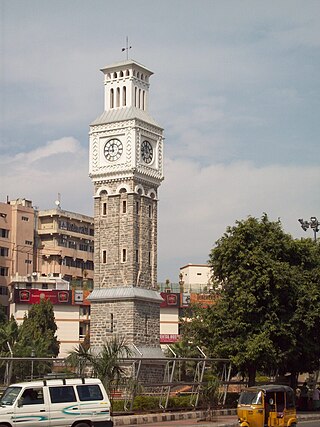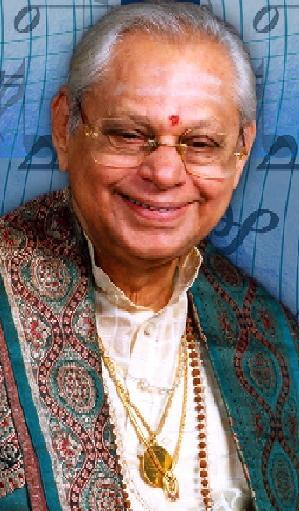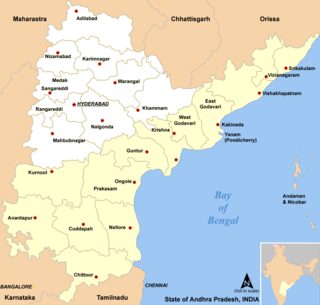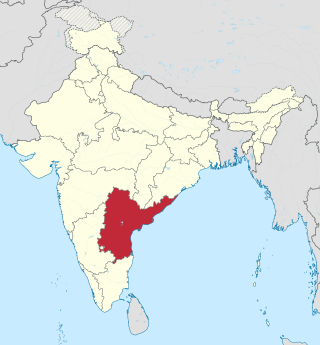
Nara Chandrababu Naidu, commonly known as CBN, is an Indian politician who is currently serving as the 13th Chief Minister of Andhra Pradesh. He holds the record of longest-serving Chief Minister in the political history of Telugu states. He is the national president of the Telugu Desam Party (TDP).

The Telugu Desam Party is an Indian regional political party with influence in the states of Andhra Pradesh and Telangana. It was founded by Telugu movie star N. T. Rama Rao (NTR) on 29 March 1982 and has focused on supporting Telugu people. The party has won a five-time majority in the Andhra Pradesh Legislative Assembly and has emerged as the most successful political outfit in the state's history. It is currently the ruling party in the Andhra Pradesh Legislative Assembly.

Telangana is a state in India situated in the south-central part of the Indian peninsula on the high Deccan Plateau. It was the eleventh largest state and the twelfth most populated state in India as per the 2011 census. On 2 June 2014, the area was separated from the northwestern part of United Andhra Pradesh as the newly formed state of Telangana, with Hyderabad as its capital. Telugu, one of the classical languages of India, is the most widely spoken and the primary official language of the state.

Rayalaseema is a geographic region in the Indian state of Andhra Pradesh. It comprises four southern districts of the State, from prior to the districts reorganisation in 2022, namely Kurnool, Anantapur, YSR, and Chittoor. Four new districts were created from these, namely Sri Sathya Sai, Nandyal, Annamayya, and Tirupati. As of 2011 census of India, the western four districts of the region had a population of 15,184,908 and cover an area of 77,424 km2 (29,894 sq mi).

Secunderabad is a twin city of Hyderabad and one of the six zones of the Greater Hyderabad Municipal Corporation (GHMC) in the Indian state of Telangana. It is the headquarters of the South Central Railway zone. Named after the Mir Akbar Ali Khan Sikander Jah, Asaf Jah III, Nizam of the Asaf Jahi dynasty, Secunderabad was established in 1806 as a British cantonment. Although both the cities are together referred to as the twin cities, Hyderabad and Secunderabad have different histories and cultures, with Secunderabad having developed directly under British rule until 1948, and Hyderabad as the capital of the Nizams' princely state of Hyderabad. Since 1956, the city has housed the Rashtrapati Nilayam, the winter office of the president of India. It is also the headquarter of the 54th Infantry Division of the Indian Army.

Nandamuri Harikrishna was an Indian politician, actor, and film producer. He served as the Member of Parliament in the Rajya Sabha, the upper house the Indian Parliament representing the Indian state of Andhra Pradesh from 2008 to 2013 and a member of the Andhra Pradesh Legislative Assembly from 1996-1999. His film works were predominantly in Telugu cinema. Harikrishna was the fourth son of actor and former chief minister of Andhra Pradesh, N. T. Rama Rao. His sons N. T. Rama Rao Jr. and Nandamuri Kalyan Ram are actors and daughter Nandamuri Venkata Suhasini is a politician.

Mahamahopadhyaya Dr. Nookala Chinna Satyanarayana was a Carnatic musician, a classical vocalist, musicologist, author and teacher, a great administrator and motivator. He was a performer on All India Radio and Doordarshan who participated in Sangeeta Sammelans, outdoor broadcasts and national programmes innumerable times. His radio lessons and Bhakti Ranjanis were very popular. He was awarded Padma Bhushan award by the Government of India in 2010.

North Andhra or Uttara Andhra, also known as Kalinga Andhra, is a geographic region in the Indian state of Andhra Pradesh. It is between the Eastern Ghats and the coast of the Bay of Bengal. It comprises six northern districts of the state, Srikakulam, Parvathipuram Manyam, Vizianagaram, Visakhapatnam, Alluri Sitharama Raju and Anakapalli. As of 2011 census of India, the region with six districts has a population of 9,338,177.

The recorded history of Andhra Pradesh, one of the 28 states of 21st-century India, begins in the Vedic period. It is mentioned in Sanskrit epics such as the Aitareya Brahmana. Its sixth-century BCE incarnation Assaka lay between the Godavari and Krishna Rivers, one of sixteen mahajanapadas. The Satavahanas succeeded them, built Amaravati, and reached a zenith under Gautamiputra Satakarni.

Burgula Ramakrishna Rao was the second and last Chief Minister of the erstwhile Hyderabad State. Prior to the independence of India and the political integration of the princely states into the Union, he was among the Telugu-speaking leaders to resist the Nizam in the princely state of Hyderabad. He was a multi lingual academic, known for his scholarship in Sanskrit and Telugu. He was also a poet and translator.

Nelakondapally, also referred to as Nelakondapalli or Nela Kondapalli, is a town and headquarters of a mandal in Khammam district, Telangana, India. It is also an archaeological site important to early Buddhism and Hinduism, where excavations have discovered a major stupa site near an ancient manmade lake, another site where Buddhist and Hindu artwork were carved in pre-3rd century India, both sites also yielding hundreds of ancient rare coins with Shaiva and Vaishnava inscriptions from the dynasties of Andhra Ikshvakus and Vishnukundinas. Nelakondapally is also the birthplace of Bhakta Ramadasu.

Hussain Sagar is a heart-shaped lake in Hyderabad, Telangana, India, built by Ibrahim Quli Qutb Shah in 1562. It is spread across an area of 5.7 square kilometres (2.2 sq mi) and is fed by the River Musi. A large monolithic statue of the Gautama Buddha, erected in 1992, stands on Gibraltar Rock in the middle of the lake. The lake separates the city centre of Hyderabad from the neighbourhood of Secunderabad. The maximum depth of the lake is 32 feet (9.8 m).
Dasaradhi Rangacharya, also spelled Dasarathi Rangacharya, was an Indian poet and writer in the Telugu language. He participated actively in the Telangana armed struggle against the rule of the Nizams. His writings incorporated the lifestyle of the people of Telangana under the rule of the Nizams. He was conferred with Kala Ratna award in 2006.

Nandamuri Taraka Rama Rao served as Chief Minister of United Andhra Pradesh for three terms, between 1983 and 1995. He was the first person to hold the office while not a member of the Indian National Congress, while representing the Telugu Desam Party (TDP), which he himself founded in 1982. Rama Rao's time in office saw his ousting in an August 1984 coup after 1½ years in office, while he was abroad in the US undergoing coronary heart surgery. He was removed by Thakur Ram Lal, the Governor of Andhra Pradesh, and replaced with Nadendla Bhaskara Rao, the finance minister. Having come back from surgery, Rama Rao regained his position through demonstrating his majority support from members of the Indian Legislative Assembly. He returned to office in September 1984.

The early 2011 Telangana protests refers to a chain of events that took place during the early months of 2011, after the Srikrishna committee report was submitted to government of India. These protests are part of Telangana movement. The Telangana political JAC declared the launch of a non-cooperation movement throughout Telangana, including the state capital at Hyderabad, starting on 17 February. The plan was to request government employees not to work; people not to pay taxes or utility bills; people not to buy tickets while using public transport; to organise rallies; to block traffic on highways; and other measures. It is reported that Congress party's central leadership told Telangana MPs that it will take a decision on Telangana after assembly elections in several states in May. On 24 February, Telangana political JAC organised Egypt-like mass protests in Hyderabad beginning 10 March. Projections for number of people to be mobilised varied from one to five million. Protesters raised slogans of 'Jai Telangana', sang pro-Telangana songs, and played games. Protesters included activists of various political parties, students, government employees, lawyers, doctors, teachers, journalists, writers and cultural artists. 48 people were arrested for the vandalism of the statues. A Telangana leader said the incident show the hatred towards leaders of Andhra and he fears more such incidents if the central government further delays the process to carve out separate Telangana state. Osmania University students warned non-Telangana staff of the university to not pass on the identities of agitators to the police and warned them they could become targets if they did not join the agitation.

Dr. Karnati Lingaiah born on 10 June 1944 in Narasimhapuram Village, Nalgonda District, Telangana, India. He is a retired Lecturer in Economics and recipient of State Best Teacher Award given by Government of Andhra Pradesh, India in 1984. He is also a poet who has written books in Telugu Language. He has authored about 17 books in Economics and 18 books in Telugu Literature.

The Culture of Telangana in India has a cultural history of about 5,000 years. The region emerged as the foremost centre of culture in Indian subcontinent during the rule of Kakatiyas, the Qutb Shahis and Asaf Jahi dynasties—. The rulers patronage and interest for culinary, arts and culture transformed Telangana into a multi-cultural region where two different cultures coexist together, thus making Telangana the representative of the Deccan Plateau and its heritage with Warangal and Hyderabad being its epicenter. Hyderabadi cuisine and Kakatiya architecture both from Telangana, are on the list of UNESCO creative city of gastronomy and UNESCO World Heritage Site. The regions major cultural events celebrated are "Kakatiya Festival" and Deccan Festival along with religious festivals Bonalu, Bathukamma, Dasara, Ugadi, Sankranthi, Milad un Nabi and Ramadan.

Andhra Pradesh, retrospectively referred to as United Andhra Pradesh, Undivided Andhra Pradesh, and Combined Andhra Pradesh, was a state in India formed by States Reorganisation Act, 1956 with Hyderabad as its capital and was reorganised by Andhra Pradesh Reorganisation Act, 2014. The state was made up of three distinct cultural regions of Telangana, Rayalaseema, and Coastal Andhra. Before the 1956 reorganisation, Telangana had been part of Hyderabad State, whereas Rayalaseema and Coastal Andhra had been part of Andhra State, formerly a part of Madras Presidency ruled by British India.



















